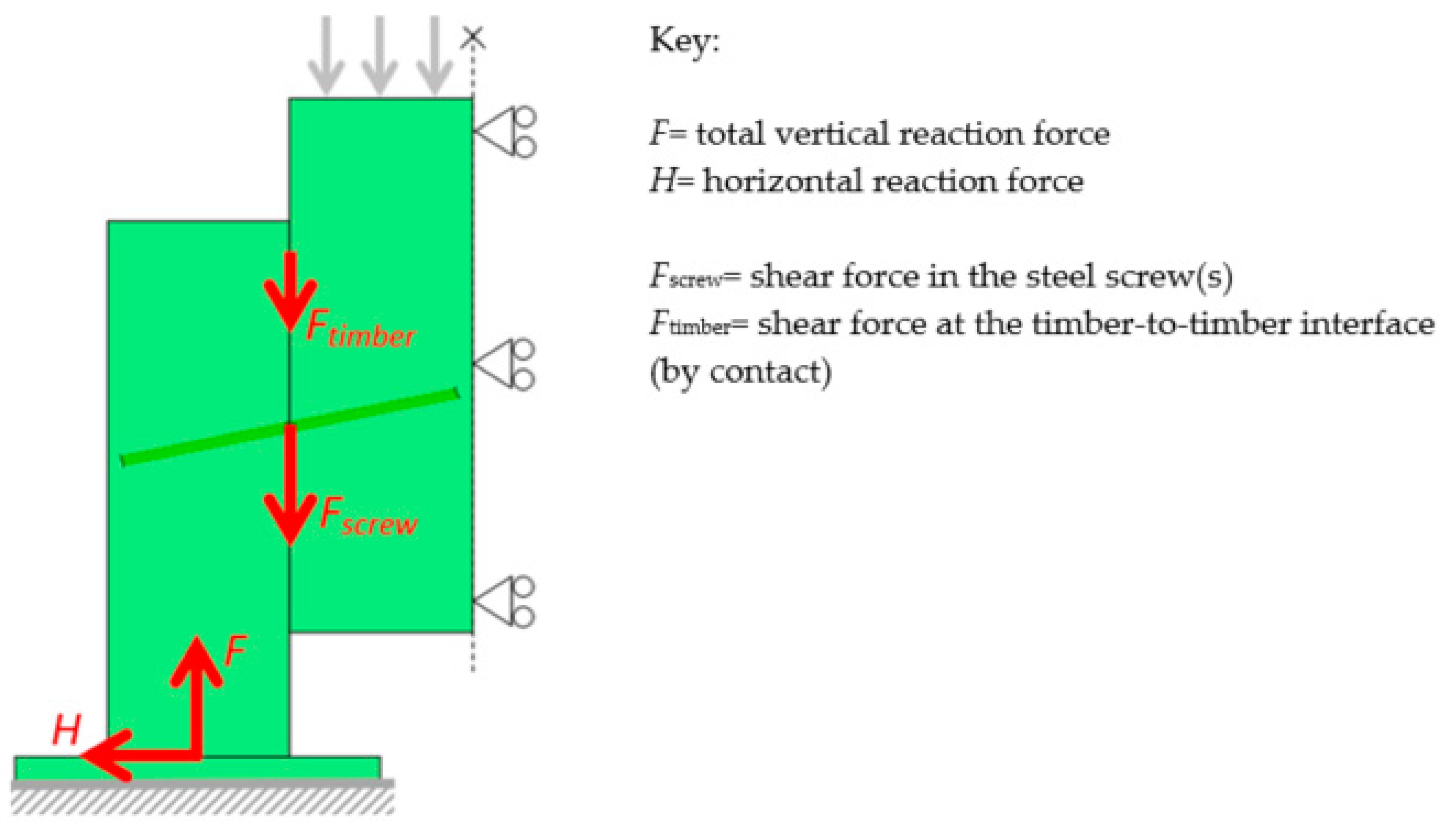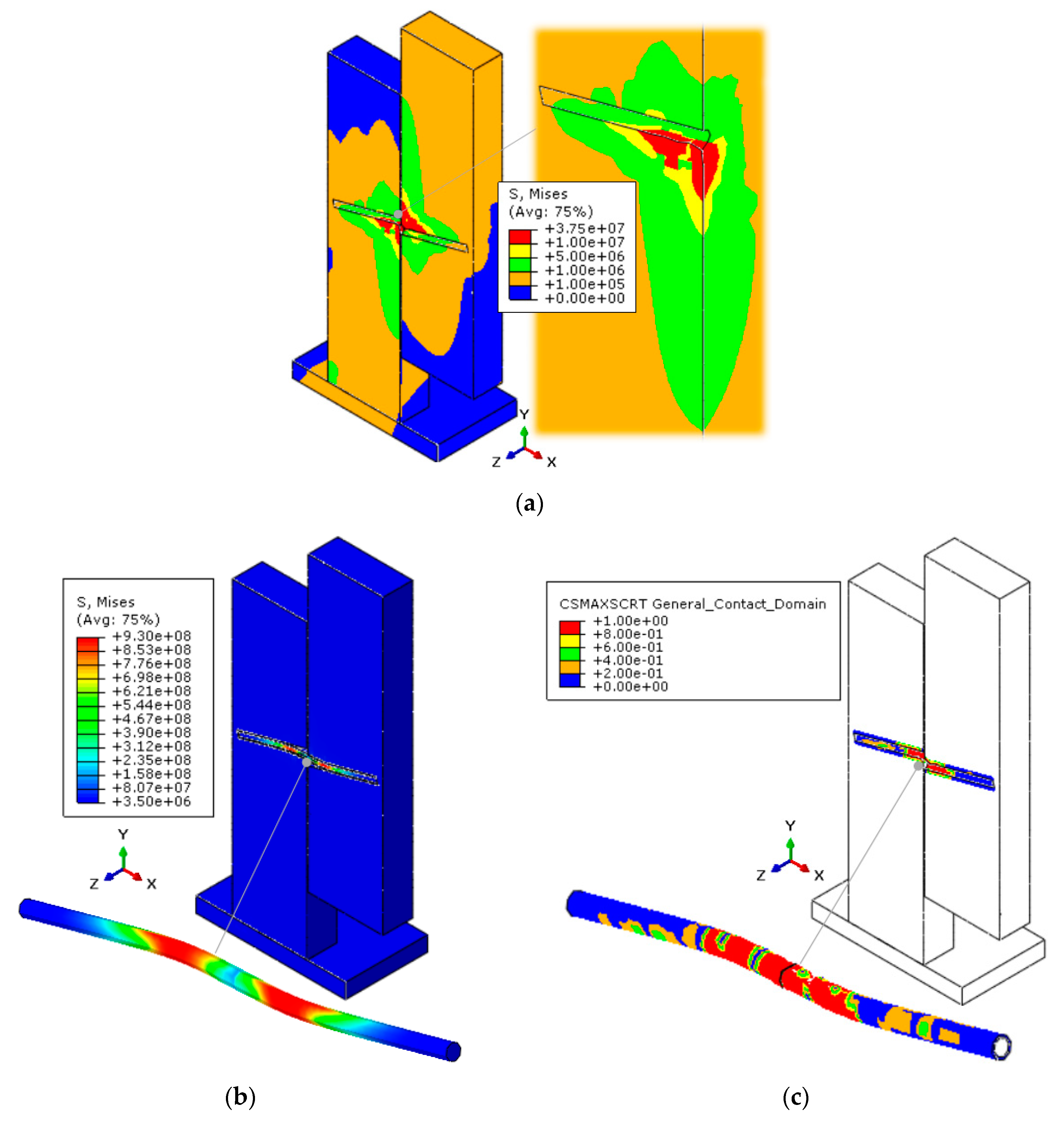Mechanical Characterization of Timber-to-Timber Composite (TTC) Joints with Self-Tapping Screws in a Standard Push-Out Setup
Abstract
:1. Introduction
2. Background
2.1. Reference Experimental Approach
2.2. Selected Push-Out Specimens and Configurations
- S#1 = is a 2 + 2 screwed joint (−45° ≤ α ≤ 45°)
- S#2 = represents a 4 + 4 screwed joint (−45° ≤ α ≤ 45°), with a1 = 70 mm ≈ 8d and d = D3
- S#3 = is a 4 + 4 screwed joint like S#3 (−45° ≤ α ≤ 45°), but a1 = 160 mm ≈ 18d
- S#4 = denotes a 2 + 2, X-shaped screwed joint (0° ≤ α ≤ 45°)
3. Reference Numerical Modelling Approach
3.1. Solving Strategy and Model Assembly
3.2. Material Properties
3.3. Mechanical Interactions and CZM Properties
3.4. Analysis of Force Contributions
4. Discussion of FE Results
4.1. Force-Slip Curves
4.2. Damage Mechanism
- crushing phenomena in timber (in the region of screws);
- progressive yielding of screws and
- damage of the CZM contact (screw-to-timber interface).
5. Mechanical Characterization of TTC Joints
5.1. Experimental Assessment of Maximum Force Predictions (Fmax)
5.2. Analytical Assessment of Maximum Force Predictions (Fmax)
5.3. Experimental and Analytical Assessment of Serviceability Stiffness Predictions (Kser)
6. Parametric FE Investigation
6.1. Mechanical Interactions and CZM Damage Parameters
6.2. Base Restraints
- BC#2: a distributed, rigid restraint at the base of the lateral timber members (Figure 17b); and
- BC#3: a mixed restraint, as obtained with a surface contact interaction between the timber member and the rigid base (to avoid possible compenetration) and an additional linear simply support (external edge of the timber member, see Figure 17c).
6.3. Friction Coefficient
- ultimate total force Fmax for a TTC given joint, as a function of μtimber;
- shear force contribution Fscrew taken up by the STSs only, as a function of μtimber.
- and serviceability stiffness Kser (calculated in accordance with Equation (4)), as a function of μtimber.
7. Conclusions
Author Contributions
Funding
Conflicts of Interest
References
- Johansen, K.W. Theory of timber connections. International association of bridge and structural engineering. Bern 1949, 9, 249–262. [Google Scholar]
- Blaß, H.J.; Bejtka, I.; Uibel, Y. Tragfähigkeit von Verbindungen mit Selbstbohrenden Holzschrauben Mit Vollgewinde; Karlsruher Berichte zum Ingenieurholzbau; KIT Scientific Publishing: Karlsruhe, Germany, 2006; Volume 4. [Google Scholar]
- Hansen, K. Mechanical properties of self-tapping screws and nails in wood. Can. J. Civ. Eng. 2002, 29, 725–733. [Google Scholar] [CrossRef]
- Ringhofer, A.; Brandner, R.; Schickhofer, G. A universal approach for withdrawal properties of self-tapping screws in solid timber and laminated timber products. In Proceedings of the 2nd International Network on Timber Engineering Research (INTER 2015), Sibenik, Croatia, 24–27 August 2015. paper INTER/48-7-1 (USB Drive). [Google Scholar]
- EN 1995-1-1. Design of Timber Structures-Part 1-1: General-Common Rules and Rules for Buildings; European Committee for Standardization (CEN): Brussels, Belgium, 1995. [Google Scholar]
- Tomasi, R.; Crosatti, A.; Piazza, M. Theoretical and experimental analysis of timber-to-timber joints connected with inclined screws. Constr. Build. Mater. 2010, 24, 1560–1571. [Google Scholar] [CrossRef]
- Girhammar, U.A.; Jacquier, N.; Källsner, B. Stiffness model for inclined screws in shear-tension mode in timber-to-timber joints. Eng. Struct. 2017, 136, 580–595. [Google Scholar] [CrossRef]
- Giongo, I.; Piazza, M.; Tomasi, R. Out of plane refurbishment techniques of existing timber floors by means of timber to timber composite structures. In Proceedings of the WCTE 2012-World Conference on Timber Engineering, Auckland, New Zealand, 16–19 July 2012. [Google Scholar]
- Giongo, I.; Piazza, M.; Tomasi, R. Cambering of timber composite beams by means of screw fasteners. J. Herit. Conserv. 2012, 32, 133–136. [Google Scholar]
- Opazo, A.; Bustos, C. Study of the lateral strength of timber joints with inclined self-tapping screws. In Proceedings of the 51st International Convention of Society of Wood Science and Technology, Concepcion, Chile, 10–12 November 2008. paper WS-39 (USB Drive). [Google Scholar]
- Ringhofer, A.; Schickhofer, G. Investigations concerning the force distribution along axially loaded Self-Tapping Screws. In Materials and Joints in Timber Structures; Aicher, S., Reinhardt, H.W., Garrecht, H., Eds.; RILEM Bookseries; Springer: Dordrecht, The Netherlands, 2015; Volume 9. [Google Scholar]
- Hossain, A.; Popovski, M.; Tannert, T. Cross-laminated timber connections assembled with a combination of screws in withdrawal and screws in shear. Eng. Struct. 2018, 168, 1–11. [Google Scholar] [CrossRef]
- Berardinucci, B.; di Nino, S.; Gregori, A.; Fragiacomo, M. Mechanical behavior of timber-concrete connections with inclined screws. Int. J. Comput. Methods Exp. Meas. Spec. Issue Timber Struct. 2017, 5, 807–820. [Google Scholar] [CrossRef] [Green Version]
- Symons, D.; Persaud, R.; Stanislaus, H. Slip modulus of inclined screws in timber-concrete floors. Struct. Build. 2010, 163, 245–255. [Google Scholar] [CrossRef]
- Jacquier, N.; Girhammar, U.A. Evaluation of bending tests on composite glulam-CLT beams connected with double-sided punched metal plates and inclined screws. Constr. Build. Mater. 2015, 95, 762–773. [Google Scholar] [CrossRef]
- Schiro, G.; Giongo, I.; Sebastian, W.; Riccadonna, D.; Piazza, M. Testing of timber-to-timber screw-connections in hybrid configurations. Constr. Build. Mater. 2018, 171, 170–186. [Google Scholar] [CrossRef]
- Silva, C.; Branco, J.M.; Ringhofer, A.; Lourenco, P.B.; Schickhofer, G. The influence of moisture content variation, number and width of gaps on the withdrawal resistance of Self Tapping Screws inserted in Cross Laminated Timber. Constr. Build. Mater. 2016, 125, 1205–1215. [Google Scholar] [CrossRef] [Green Version]
- ABAQUS Computer Software; v.6.14, Simulia; Dassault Systemes: Providence, RI, USA, 2020.
- ABAQUS Documentation and Uses’ Guide; v.6.14, Simulia; Dassault Systemes: Providence, RI, USA, 2020.
- Avez, C.; Descamps, T.; Serrano, E.; Léoskool, L. Finite Element modelling of inclined screwed timber to timber connections with a large gap between the elements. Eur. J. Wood Wood Prod. 2016, 74, 467–471. [Google Scholar] [CrossRef] [Green Version]
- Bedon, C.; Fragiacomo, M. Numerical analysis of timber-to-timber joints and composite beams with inclined self-tapping screws. Compos. Struct. 2019, 207, 13–28. [Google Scholar] [CrossRef]
- EN 12512:2001. Timber Structures-Test Methods-Cyclic Testing of Joints Made with Mechanical Fasteners; European Committee for Standardization (CEN): Brussels, Belgium, 2001. [Google Scholar]
- EN 26891:1991. Joints Made with Mechanical Fasteners-General Principles for the Determination of Strength and Deformation Characteristics; European Committee for Standardization (CEN): Brussels, Belgium, 1991. [Google Scholar]
- EN 338:2003. Structural Timber-Strength Classes; European Committee for Standardization (CEN): Brussels, Belgium, 2003. [Google Scholar]
- EN 1194:1999. Timber Structures-Glued Laminated Timber-Strength Classes and Determination of Characteristic Values; European Committee for Standardization (CEN): Brussels, Belgium, 1999. [Google Scholar]
- ETA-11/0190. Würth Self-Tapping Screws-Self-Tapping Screws for Use in Timber Constructions; European Organization for Technical Approvals (EOTA): Brussels, Belgium, 2016. [Google Scholar]
- Rothoblaas-WT Double thread connector-Technical Data Sheet. Available online: https://www.rothoblaas.com/products/fastening/screws (accessed on 22 February 2020).
- Murase, Y. Friction of wood sliding on various materials. J. Fac. Agric. Kyushu Univ. 1984, 28, 147–160. [Google Scholar]























| Elastic Moduli (Mean Values, in MPa) | Parallel to the grain E┴ | 11600 |
| Perpendicular to the grain E║ | 390 | |
| Radial E | 390 | |
| Longitudinal shear modulus G | 690 | |
| Resistance (Mean Values, in MPa) | Compression parallel to the grain fc,0 | 37.5 |
| Compression perpendicular to the grain fc,90 | 3.57 | |
| Shear fv | 3.85 | |
| Failure (Mean Values) | Maximum stress fc,90 (MPa) | 5 |
| Damage evolution | Linear | |
| Failure displacement δu (mm) | 4 |
| Soft Layer | Elastic moduli (mean values) | Longitudinal (screw axis) | MPa | 370 |
| Tangential | MPa | 370 | ||
| Shear | MPa | 720 | ||
| Radial | MPa | 50 | ||
| Failure | Maximum shear (MPa) | MPa | 5 | |
| Damage evolution | - | Linear | ||
| Failure displacement δu (mm) | Mm | 4 | ||
| CZM Contact Interaction | Resistance (mean values) | Longitudinal | MPa | 37.55 |
| Transverse | MPa | 3.85 | ||
| Shear | MPa | 3.85 | ||
| Rolling shear | MPa | 3.5 |
© 2020 by the authors. Licensee MDPI, Basel, Switzerland. This article is an open access article distributed under the terms and conditions of the Creative Commons Attribution (CC BY) license (http://creativecommons.org/licenses/by/4.0/).
Share and Cite
Bedon, C.; Sciomenta, M.; Fragiacomo, M. Mechanical Characterization of Timber-to-Timber Composite (TTC) Joints with Self-Tapping Screws in a Standard Push-Out Setup. Appl. Sci. 2020, 10, 6534. https://doi.org/10.3390/app10186534
Bedon C, Sciomenta M, Fragiacomo M. Mechanical Characterization of Timber-to-Timber Composite (TTC) Joints with Self-Tapping Screws in a Standard Push-Out Setup. Applied Sciences. 2020; 10(18):6534. https://doi.org/10.3390/app10186534
Chicago/Turabian StyleBedon, Chiara, Martina Sciomenta, and Massimo Fragiacomo. 2020. "Mechanical Characterization of Timber-to-Timber Composite (TTC) Joints with Self-Tapping Screws in a Standard Push-Out Setup" Applied Sciences 10, no. 18: 6534. https://doi.org/10.3390/app10186534
APA StyleBedon, C., Sciomenta, M., & Fragiacomo, M. (2020). Mechanical Characterization of Timber-to-Timber Composite (TTC) Joints with Self-Tapping Screws in a Standard Push-Out Setup. Applied Sciences, 10(18), 6534. https://doi.org/10.3390/app10186534






